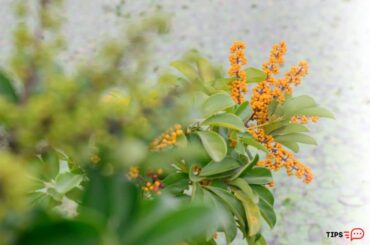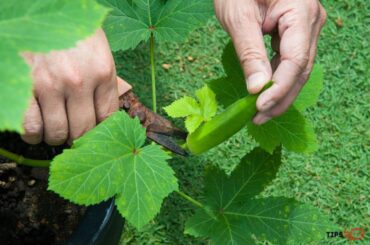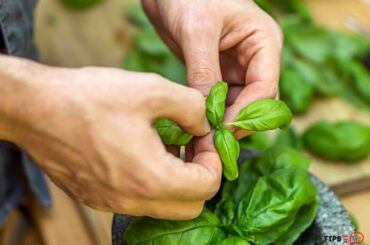The orchids that you buy from the stores have been housed in small pots. You definitely have this question when you buy a plant from a store: “Should I repot my orchid after buying?” Keep reading the article to learn more.

Should I repot my orchid after buying?
It is not essential to repot the orchid as soon as you bring them home. Give them some time to adjust to a new environment. If you think the orchid needs a bigger pot or new soil mix you can repot them after a week or two. Until then just keep a close look.
The luxurious beauty and the tremendous diversity have made orchids one of the most demanded houseplants. Most of the orchids we find on grocery store shelves come from tropical climates. In fact, orchids are native to tropical rainforests.
There, they grow on plant surfaces or other objects above the ground level. Besides hiding in the soil, their roots prefer to stay in the air. Warmth, moist air currents, rain, and shady conditions in rainforests create a heaven for these beauties. Unlike in their natural habitats, you are going to raise them in a cool and dry environment.
You are not supposed to have a green thumb to keep orchid plants alive. Regardless of how much black thumb you might believe you have, you can ensure the healthy growth of these exotic beauties in your living space. All you need is a good understanding of the plants’ requirements in order to thrive.
What to do after buying an orchid?
Once you get your orchid home from the store, you will be introducing your plant to a new environment. If you introduce the orchid to a drastically different environment than it was previously in, the orchid may be shocked and stressed. This may lead to damage to the plant or stunt its growth.
When bringing orchids into your house, there are a few things to keep in mind. Temperature, humidity, light, and airflow in the environment should be just right to support the healthy growth of your newly purchased orchids. In addition, the inputs in terms of soil, water, and nutrients should be compatible with the plant’s requirements.
The first thing you should do is place your orchid where the environment best matches the conditions of its natural habitat.
Maintain the favorable warmness around the plant
After purchasing orchids, do not place them in any location in which they will become chilled or frozen.
Orchids are tropical plants, so they love to grow in a warm place. If you choose to locate the orchid plant indoors, especially in your room, be mindful that the temperature of the air conditioning unit is not going to hinder the healthy growth of your orchids.
For orchids, it is crucial to maintain the temperature of the room within the range of 20–30 oC during the day and 16–19 oC at night.
Similarly, if you wish to grow your newly acquired orchids in your yard, avoid exposing them to extreme temperature fluctuations. If you feel the outdoor temperature is extremely high or if it is too low, bring your plant inside and place it in a warmer room.
Keep it in a well-sunlit area
Orchids thrive in bright and indirect light. Keep your orchid pot in a sunlit area, ideally closer to an east-facing or north-facing window. Southern-facing and west-facing windows are likely to expose your plant to direct and strong sunlight, so it might burn your plant. Windowsills to place your orchids are okay only if you use sheer curtains to filter the light that reaches the orchid plant.
Find a moist environment for your orchids
Orchids prefer to grow and bloom in a damp environment. Arid air in the plant’s environment may possibly retard the healthy growth and the development of orchids. If the room is dry, the orchid can be kept temporarily inside your bathroom, so it will get enough moisture around it. Alternatively, you can mist the plant or you can place it on a humidity tray to keep your plant happy in a moist environment.
Make sure there is good airflow around the orchid
Fresh air is beneficial for orchids. Stagnant air around the plant can suffocate the plant. Orchids may develop weak stems and be drawn when the air around them is not moving. Therefore, providing good ventilation for the orchid is important.
However, do not place your orchid in a windy location, as it will lose moisture unnecessarily, causing it to wilt.
Unless you notice the orchid has a lot of air roots or tends to grow outside of the pot, you can leave it in the same pot and potting medium it came in for a period of time until it requires repotting. In the latter part of this article, we have given a complete guide to how to repot your orchid.
Like any other living being, orchids also need water and a proper diet to thrive. The irrigation and fertilization of orchids to promote growth and blooming is a mystery to most gardeners. Yes, obviously they are a must for your plants.
However, if you misuse them for your lovely orchids, you will probably end up in chaos. Continue reading this article. You will gain all the solutions to your uncertainties regarding this matter.

When to repot orchids?
Repotting of your orchid is essential once you see dead roots of the plant resulting from degradation of the potting medium, and the plant tends to overgrow the pot or has developed a lot of air roots.
The organic materials that the orchid growing medium is composed of decay and break down over time. Thus, the medium becomes compact and declines its nutritive value, water retention capacity, and aeration ability to keep orchid roots alive.
Roots may die as a result of this. If this happens, the plant may lose its vitality unless you change the growing medium as soon as possible. Don’t be late to repot your plant if you notice the drooping of leaves at the bottom of the plant.
Orchids develop air roots that are specialized to take up nutrients, minerals, and moisture from the air. When you see your orchid has developed a lot of aerial roots, perhaps it indicates that it is not getting enough nutrients from the soil.
In sympodial orchids like Dendrobium, Cattleya, and Oncidium, the new growth occurs at their base. The orchid is considered to have outgrown its pot when it’s rhizome, pseudobulbs, or roots exceed the edge of the pot.
On the other hand, monopodial orchids like Phalaenopsis grow upwards continually while developing more roots at the base of the stem. Along with the plants’ growth, orchids need more nutrients and space to grow. Repotting orchids is the most effective approach to address this issue.
Orchids, in general, are supposed to be repotted every 2–3 years. Anyway, this depends on the orchid species you have. Some orchid species should be repotted every year.
After the flowering season, it’s best to repot your orchid. If you repot an orchid while it is blooming, the plant will be stressed, potentially destroying the flowers or causing them to droop prematurely. After flowering, orchids go through a resting or dormancy period. It would be preferable if you could repot the orchid at this time.
What to soak orchid roots in before repotting?
The most common practice to loosen the growing substrate is to soak the orchid pots in water. You can use cool water to soak the roots. Cold or hot water is not suitable to soak the pot as it can certainly damage the roots.
How to repot an orchid with air roots?
Now you know that you have to repot your orchid whenever you see extensive aerial root growth. Phalaenopsis, or moth orchids, are the best examples of orchids that have a higher potential for developing air roots than other orchids.
Here we have given you the complete directions on how to repot your moth orchid with a lot of air roots.
Gather all materials and tools in advance
You may need:
- Chopstick or any kind of blunt stick
- Pruning shear or pair of scissors
- New potting medium
- Orchid pot or clay pot
- Water bucket
- Any household disinfectant ( hydrogen peroxide, lysol, phenol, bleach, rubbing alcohol, dish soap)
- Spray bottle
It is good to have all the tools and materials that you need before you start the process. It will be convenient for you if you could find a place where a water source nearby.
Remember that you cannot repot your orchid in the same pot or with the same potting soil.
Find a pot that is 1-2 inches wider than the previous pot. Obviously, your plant requires extra space, but too much space all of a sudden is not a good idea. Besides blooming, the orchid may use more energy just for root growth.
Unfortunately, your orchid may not produce flowers for several months if you choose to use larger pots. Furthermore, make sure that the pot has holes or slits to encourage free draining and also aeration.
Look for a new potting medium for the plant. You can prepare your own potting mix or you can purchase suitable soil from your local garden center or plant nursery. If you want to prepare a homemade potting mix for orchids, simply mix 4 parts of coco husks or fir bark with 1 part of charcoal and perlite to prepare.
Disinfect the cutting tools in advance. This helps kill undesirable microbes on them and minimizes the risk of contamination.
Soak the pot in water
Dip the pot in a bucket of water and leave for about 30 minutes. This leads to loosening the potting medium. Then take the pot out and drain excess water.
Take the plant out
You can use a blunt stick to loosen the potting medium further. Remove your plant from the pot with care. Grasp the stem from the base below the lowest leaves to pull the plant. With your fingers, gently remove any leftover potting medium from the roots and untangle the roots.
Orchid roots are fragile. Be careful not to damage or break them. Pay your fullest attention to freeing the roots. Discard the old potting medium.

Examine the roots
See whether there are any unhealthy or dead roots in the plant. Healthy roots appear in silvery gray or light green color.
If you see any mushy dark green, brown, or black roots, remove them with a sterilized pruning scissor. The presence of such rotten roots in your plant means that you have been overwatering it. So, changing your watering schedules will help you to prevent the repetition of the problem.
In order to prevent spreading of diseases, it is important to sterilize your scissors after each cut. Just spray the disinfectant solution onto the scissors or rub some alcohol onto them to sterilize them. Once it is done, lay the plant on a newspaper or dry cloth.
Sterilize orchid roots
It is a good idea to sterilize the root system of your plant to get rid of potential disease vectors. You can simply spray 3% hydrogen peroxide solution onto the roots. Higher concentrations of peroxides can harm the roots. If the concentration of the peroxide solution that you have is high, make sure to dilute it before spraying.
If you don’t have hydrogen peroxide with you, don’t worry. A small amount of cinnamon powder will do this job well. Just apply a thin layer of ground cinnamon on the cut ends of the roots. However, avoid applying cinnamon powder on healthy roots as it causes toots to dry quickly.
Get to your pot and the potting medium ready
Do not forget to sterilize the pot before using especially, if you use the same pot. Wash the pot with boiling water to kill pathogenic microbes and their spores.
Better if you can soak the potting medium in hot water for a couple of hours before filling them into the pot. This helps to absorb water into the materials, so they will hold enough moisture for your plant. Strain the medium and let it come to room temperature. Then fill 1/3 of the pot with the medium.
Place the orchid in the new pot
Place the orchid in the middle of the pot so you can give more space to the roots to grow towards the sides of the pot. Do not bend the roots unnecessarily.
Direct the aerial roots towards the holes or slits of the pot. Never bury them or force them to grow into the pot, as it can result in an unhealthy plant.
Fill the growing medium
Now you can fill the pot with the medium. Add the medium a little at a time. It will be easy for you to use a blunt stick to press the medium to the gaps between roots. Shake the pot and tap on it to settle the medium well. Be mindful to not compact the medium so tightly inside the pot.
Leave enough air space between the roots and the medium. Burry as many old roots as possible. The plant must be able to stand upright after filling the medium.
Keep the pot in a suitable place
Well done now you have completed repotting your orchid. You can place your pot in a shady, warm, moist, and well-ventilated area. Usually, repotting process is stressful for the plant. Therefore, once you repot the plant do not keep the pot in the direct sunlight at once. Keep the pot in a shady area but not too dark for about 1-2 days then you can bring it to the bright light.

Can I repot an orchid in regular potting soil?
Absolutely no, you should never use regular potting soil for your orchids if you want them to perform at their best.
Unlike terrestrial plants, orchids are air plants. Rather than digging into the soil, orchid roots do prefer to grow in the air.
In rainforests, orchids grow on trees wrapping their roots around the branches. Roots absorb an ample amount of nutrients and water from continuously moving air currents. But, when we grow orchids in our vicinity they have to be potted or mounted.
The growing medium is much more vital for the optimal growth and the development of orchids. As a matter of fact, orchids need their media to be chunky and coarse in order to provide surfaces to cling to the roots and to create enough air pockets to facilitate the good gas exchange between the roots and the medium.
In addition, the medium should be loose as it favors free draining. Waterlogged soil is detrimental for orchids as it causes rotting of the roots. Further, the pH of the medium should be in the range of 5.5. to 6.5. Potting soil for orchids is often prepared by mixing ingredients like coconut husks, fir bark, and perlite.
Regular potting soil has qualities that are very different from those outlined above. They are denser, which increases the risk that the roots will suffocate because the medium won’t have enough room for aeration.
Apart from that, the soil will take a long time to drain. As a result, if you just use ordinary potting soil for orchids, you risk killing your plant.
What is the easiest way to repot an orchid?
In fact, soaking orchid pots in water makes the repotting process so easy. Usually, roots can tightly cling to the potting medium so it might damage the roots when you remove the medium. However, if you soak the pot for enough time, usually for 30 minutes, the growing medium becomes softened so you can easily get rid of them.
How do you keep store-bought orchids alive?
There’s no doubt that seeing beautiful, long-lasting vibrant blossoms in your orchids will make you happy. How will you keep your orchids alive so that they can bloom again and again?
You’ve learned how to create a favorable environment for your orchids’ healthy growth. Other than those environmental factors, you must ensure that the other inputs, like nutrients and water, are adequate to meet the needs of the plants. Here are some simple tips to keep your orchids alive.
Feed the orchids with a nutrient-rich diet
Nutrient deposits in the soil deplete with time. Therefore, you have to replenish those with a proper diet. You can apply a slow-releasing balanced fertilizer 20-20-20 for example once every two weeks when orchids are not blooming. When orchids are fed a phosphorus-rich diet, they are pleased to bloom. It is recommended the application of a weak dose of fertilizer weekly for the orchids.
Usually, in the cooler seasons, orchids are not actively growing. Therefore, you don’t have to apply fertilizers consistently. Avoid over-application of fertilizers for orchids. Higher levels of salt-build ups can be toxic for your plants.
Follow a right water schedule
Your watering habit directly links with plant health. Most plant parents end up with root rot due to overwatering the orchids. Water orchids whenever they need it.
Wait until the soil becomes partially dry to water your orchids. Feel the dampness of soil 1-2 inches beneath with your fingers. If the soil is dry, water the plant; if not, wait until the next day to water it.
The plant’s water needs fluctuates depending on external factors like temperature and humidity. The plant will lose more water through transpiration in a hot, dry atmosphere, so you should water it more frequently. However, if the weather is moist and the temperature is low, you may not need to water your plants as frequently.
Water your orchids in the morning so it has enough time to dry during the day time. Do not leave your plants wet for too long. Wipe excess water with a paper towel. It can protect the orchids from diseases like crown rot.
Remove dead flowers and spikes
If you cut the dead blossoms, the plant can store nutrients and redirect them for future growth and development. It may be a heartbreaking task for you to do so, but you must do it in order to keep your plant alive.
To wrap up
Orchids are amazing plants that can add a touch of elegance to your home. Repotting, correct watering practices, and feeding schedules are crucial in order to ensure the survival of the orchids. As long as you provide the right environment for your orchids they can reward you with their breathtakingly beautiful flowers.
After reading this article I am sure you will get an answer to the question “Should I repot my orchid after buying?”. Happy gardening to you all.
Read Next : How To Treat Orchid Root Rot | 11 Proven Methods |




